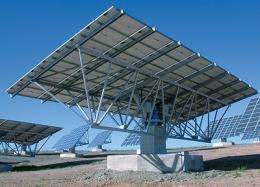Solar panels track the sun for more efficiency

Photovoltaic modules equipped with a moveable mounting and a new control system from Siemens are able to precisely follow the course of the sun. Thanks to a new algorithm based on astronomical data, the solar panels track the sun in line with not only the time of day but also the time of year and the precise geographical location of the photovoltaic installation. As a result, their energy yield is more than 35 percent higher than fixed systems.
A decisive factor in the efficiency of a photovoltaic system is the angle of incidence at which sunlight strikes the surface of the module. In the case of fixed panels, sunlight hits the solar cells at an oblique angle for most of the day. A maximum yield in terms of energy and therefore electricity is only achieved when sunlight strikes the cells perpendicular to their surface. So the obvious solution is to fit the solar modules to a movable tracking system that precisely follows the course of the sun. The sun’s position depends on not only the time of day but also the time of year and the location of the photovoltaic installation. The Simatic S7-1200 control system from Siemens therefore calculates the perfect alignment for the solar modules on the basis of their precise location, anywhere in the world, and the exact time and date.
This calculation is based on the “Simatic Library for Solar Position Algorithm,” which is stored in every control unit. Siemens obtained a license for the very precise algorithm from the National Renewable Energy Laboratory (NREL) in the U.S. On this basis, the control system is able to determine the position of the sun to an accuracy of 0.0003° and align the photovoltaic module accordingly. Three-phase AC motors power a dual-axis tracking system: This swivels the module in a semicircle along the azimuthal axis, thus tracking the sun’s daily course from east to west, and tilts the module along the zenithal axis, tracking the height of the sun according to the time of day and year. In the process, the control system also prevents neighboring modules from overshadowing one another during the morning and evening hours, when shadows are especially long. The software bases its astronomical calculations on parameters such as longitude, latitude, and the exact time.
In addition, the control system can also take weather conditions into account. When faced with high winds, for example, it moves the modules to a position of least resistance, where they can withstand winds of up to 130 kilometers per hour. In a similar manner, the tracking system can be programmed to react to snow, thunderstorms, fog, and darkness.
Source: Siemens

















